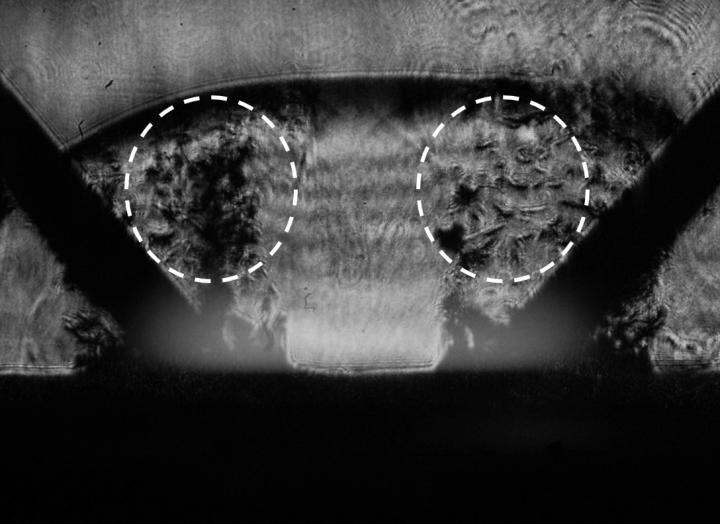May 16 2019
With the global increase in the number of electronic devices, the discovery of effective methods for recycling electronic waste (e-waste) is of great interest. Approximately 50 million tons of e-waste is produced every year, of which only 20% is recycled.
 This is a Schlieren image of the shock wave plastic/metal separation induced by the pulsed electric discharge at 4.35 µs. Fragments of the plastic and metal layers (indicated by the white circles) are clearly seen being blown away from the tips of the electrodes where the electric discharge has occurred. (Image credit: Prof. Hamid Hosano)
This is a Schlieren image of the shock wave plastic/metal separation induced by the pulsed electric discharge at 4.35 µs. Fragments of the plastic and metal layers (indicated by the white circles) are clearly seen being blown away from the tips of the electrodes where the electric discharge has occurred. (Image credit: Prof. Hamid Hosano)
A major portion of the remaining 80% becomes a landfill, leading to an environmental issue. At present, e-waste recycling entails chemical baths and mechanical crushers, which are costly and labor-intensive and can lead to significant environmental and health problems when not carried out properly. Hence, scientists from Kumamoto University, Japan, have been using pulsed power (pulsed electric discharges) to design a more efficient and cleaner recycling method.
Pulsed power is found to be potential in processing many waste materials, from concrete to wastewater. Scientists studied its effectiveness in isolating the components found in one of the most prolific kinds of e-waste, CD ROMs, for testing its potential to be used in e-waste recycling.
In their earlier study, they demonstrated that separation of metal from plastic took place completely using 30 pulses at approximately 35 J/pulse. (With the existing electricity price in Tokyo, this amount of energy costs about 0.4 Yen for recycling 100 CD ROMs.) To study the material separation mechanism with this method, scientists carried out more analyses by observing the plasma discharge using a high-speed camera, by taking Schlieren visualizations to evaluate the shock wave, and by using shadowgraph images to measure the fragment motion.
In the initial stage of electrical discharge, images revealed two distinct emissions of light, namely, blue-white and orange, denoting the excitation of aluminum and upper protective plastic materials, respectively. Once the plasma is dissipated, metal and plastic fragments are found to scatter from the CD ROM sample.
Schlieren images were obtained for the entire process and showed that the main destructive shock waves formed around the two electrodes. The shock generated a pressure of more than 3.5 MPa (nearly the same amount of pressure a galloping horse would exert on the ground) near the electrode tips and quickly decreased to less than 0.8 MPa at 7.1 mm. Material dispersal was very clearly seen in the Schlieren and shadowgraph images.
E-waste is perhaps one of the most important waste recycling problems we face today due to its ubiquitous nature. Our project showed the importance of shock waves when using pulse power for material removal and separation in e-waste recycling. We believe our data will be important in the development of future recycling projects.
Hamid Hosano, Professor, Kumamoto University
Hosano is also the study leader. This study has been published online in Waste Management on April 3rd, 2019.